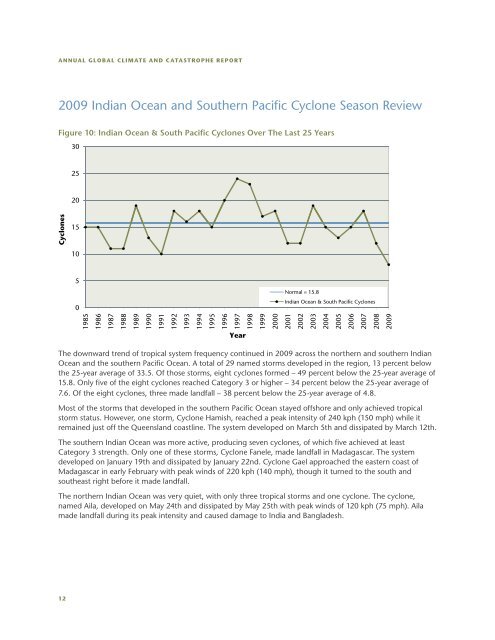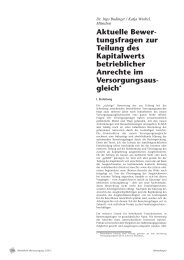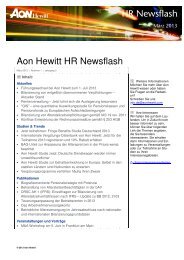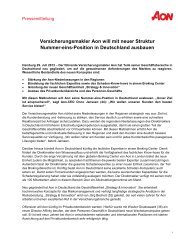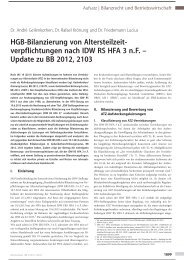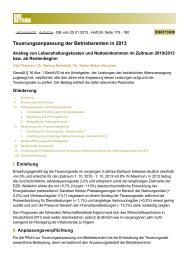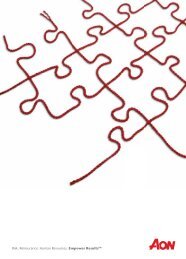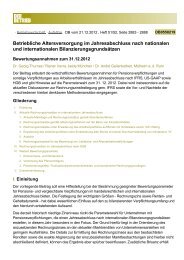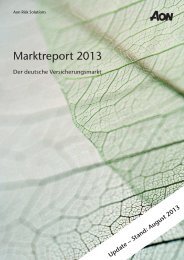Annual Global Climate and Catastrophe Report: Impact ... - Aon
Annual Global Climate and Catastrophe Report: Impact ... - Aon
Annual Global Climate and Catastrophe Report: Impact ... - Aon
Create successful ePaper yourself
Turn your PDF publications into a flip-book with our unique Google optimized e-Paper software.
AnnuAl GlobAl Cli mAte And C AtAstroph e r e port<br />
2009 Indian Ocean <strong>and</strong> Southern Pacific Cyclone Season Review<br />
Figure 10: Indian Ocean & South Pacific Cyclones Over The Last 25 Years<br />
Cyclones<br />
The downward trend of tropical system frequency continued in 2009 across the northern <strong>and</strong> southern Indian<br />
Ocean <strong>and</strong> the southern Pacific Ocean. A total of 29 named storms developed in the region, 13 percent below<br />
the 25-year average of 33.5. Of those storms, eight cyclones formed – 49 percent below the 25-year average of<br />
15.8. Only five of the eight cyclones reached Category 3 or higher – 34 percent below the 25-year average of<br />
7.6. Of the eight cyclones, three made l<strong>and</strong>fall – 38 percent below the 25-year average of 4.8.<br />
Most of the storms that developed in the southern Pacific Ocean stayed offshore <strong>and</strong> only achieved tropical<br />
storm status. However, one storm, Cyclone Hamish, reached a peak intensity of 240 kph (150 mph) while it<br />
remained just off the queensl<strong>and</strong> coastline. The system developed on March 5th <strong>and</strong> dissipated by March 12th.<br />
The southern Indian Ocean was more active, producing seven cyclones, of which five achieved at least<br />
Category 3 strength. Only one of these storms, Cyclone Fanele, made l<strong>and</strong>fall in Madagascar. The system<br />
developed on January 19th <strong>and</strong> dissipated by January 22nd. Cyclone Gael approached the eastern coast of<br />
Madagascar in early February with peak winds of 220 kph (140 mph), though it turned to the south <strong>and</strong><br />
southeast right before it made l<strong>and</strong>fall.<br />
The northern Indian Ocean was very quiet, with only three tropical storms <strong>and</strong> one cyclone. The cyclone,<br />
named Aila, developed on May 24th <strong>and</strong> dissipated by May 25th with peak winds of 120 kph (75 mph). Aila<br />
made l<strong>and</strong>fall during its peak intensity <strong>and</strong> caused damage to India <strong>and</strong> Bangladesh.<br />
12<br />
30<br />
25<br />
20<br />
15<br />
10<br />
5<br />
0<br />
1985<br />
1986<br />
1987<br />
1988<br />
1989<br />
1990<br />
1991<br />
1992<br />
1993<br />
1994<br />
1995<br />
1996<br />
1997<br />
Year<br />
1998<br />
1999<br />
2000<br />
Normal = 15.8<br />
Indian Ocean & South Pacific Cyclones<br />
2001<br />
2002<br />
2003<br />
2004<br />
2005<br />
2006<br />
2007<br />
2008<br />
2009


